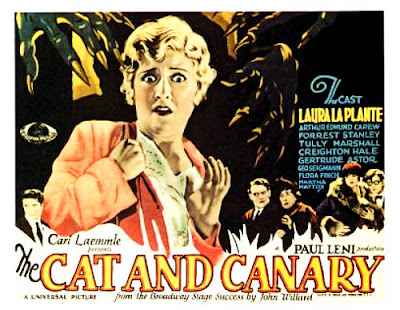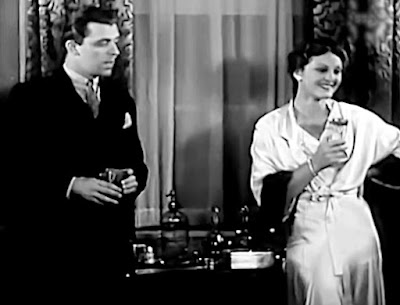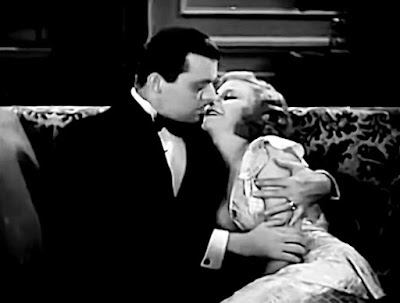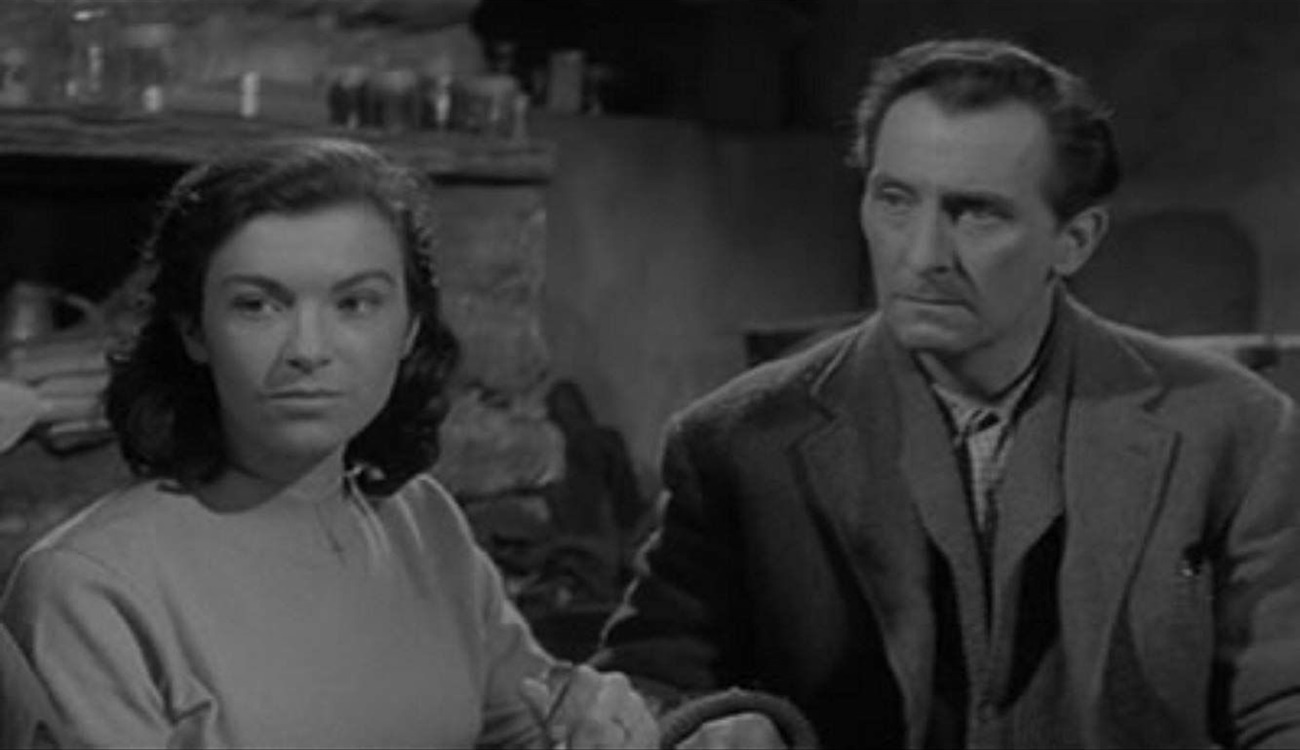Now Playing: The Thirteenth Guest (1932)
Pros: Good, energetic cast seems to be having fun with the material; The mad killer has a highly unusual modus operandi.
Cons: Plot is bewilderingly complex and ultimately doesn't make much sense
This post is part of the second annual "Favorite Stars in B Movies" blogathon hosted by Yours Truly. You won't want to miss all the other great posts about the stars who lit up the Bs, right here on this site!
"Sure he [Fred Astaire] was great, but don't forget that Ginger Rogers did everything he did, ...backwards and in high heels." - Bob Thaves, Frank and Ernest (cartoon, 1982)
Ginger Rogers, the epitome of grace and beauty in some of Hollywood’s greatest, most beloved musicals, was apparently born to dance: "My mother told me I was dancing before I was born. She could feel my toes tapping wildly inside her for months." [Ginger Rogers, Ginger Rogers: My Story, 1991)
But in the Hollywood of the 1930s, desire and natural ability were not nearly enough -- to become a larger-than-life dancer on the big screen, you had to have the grit and determination of a Visigoth, and Rogers had that in spades.
Even though Rogers won a best actress Oscar for her dramatic portrayal of Kitty Foyle (1940), for better or worse (for richer or poorer, in sickness or in health, for as long as there are fans who remember…) she will always be best known for tripping the light fantastic with Fred Astaire in ten films.
Interestingly, it was Ginger Rogers -- barely into her 20s and 12 years younger than her new dance partner -- who was the grizzled movie veteran when she and Astaire first paired up in Flying Down to Rio (1933). Rogers had over two dozen movies on her resume at the time, while Astaire was just getting started, having appeared in only one other.
Leading up to that breakout appearance, Rogers might have thought she was moving backwards in high heels as far as her movie career was concerned. For every small part in an A picture like 42nd Street or Gold Diggers of 1933, there was seemingly an endless supply of roles (albeit some leading ones) in uninspired Bs like The Sap from Syracuse or Carnival Boat.
The Thirteenth Guest came a little over mid-way through Roger’s marathon run through the Bs in the early part of her career. But unlike The Sap from Syracuse and its ilk, The Thirteenth Guest has stayed around, kicked up its feet and made itself at home -- as in home video releases.
At first glance, it may not be exactly clear why The Thirteenth Guest made it all the way to home video while most of Rogers’ other Bs fell by the wayside. Produced at Monogram Pictures, one of the “Poverty Row” studios of Hollywood’s Golden Age that specialized in churning out Bs, The Thirteenth Guest was based on a 1929 novel by noted crime author Armitage Trail (aka, Maurice R. Coons, best known for his novel Scarface, later turned into the hit 1932 movie with Paul Muni).
The Thirteenth Guest is highly reminiscent of 1927’s popular mystery-thriller The Cat and the Canary, which itself was based on a successful play from the early ‘20s. (The Cat and the Canary is supposed to have influenced James Whale’s brilliant dark comedy The Old Dark House, and both in turn influenced a whole generation of “old dark house” films.)
Guest and Cat rely on a familiar set-up: after the death of a wealthy patriarch, the potential heirs gather like vultures at the creepy old ancestral mansion to find out who is to inherit the fortune. When the guests start getting bumped off one-by-one, fear, loathing and suspicion erupt among the survivors.
 |
| The Cat and the Canary set the stage for the madness of The Thirteenth Guest. |
Whereas The Cat and The Canary injected yet another soon-to-be cliche into the mix -- a homicidal maniac on the loose -- The Thirteenth Guest went with a more subtle (?) form of madness.
Guest tries to distinguish itself with about as complicated a plot as you could possibly cram into a 70 minute B picture. Thirteen years ago the patriarch of the Morgan family had invited thirteen of his closest friends, relatives and confidantes (including the family lawyer Barksdale) to his mansion for a dinner party, where he was to reveal the details of his will. It seems the bulk of his estate was to go to a mysterious, unnamed thirteenth guest, but the guest never showed up and the elderly Morgan died (or was murdered) before the person’s identity could be revealed.
In the film’s present day, Marie Morgan (Rogers), daughter of the deceased millionaire, has just turned 21, and for some reason is poking around the now deserted mansion. Although the house was long ago abandoned after the elder Morgan’s death, someone has turned the electricity back on, installed a working telephone, and set up the dining room exactly as it was thirteen years ago.
In classic old dark house fashion, a scream rips the night, whereupon the panicked cab driver who delivered Marie to the house takes off to summon the police. Police Captain Ryan (J. Farrell MacDonald) and his numbskull assistant Detective Grump (Paul Hurst) discover Marie’s dead body, seated at the dining table as if waiting for other guests to arrive.
 |
| "She died waiting for the hors d'oeuvres to be served..." |
Captain Ryan, who immediately realizes he needs more brain power on the case, calls in a brilliant, snarky playboy/private investigator, Phil Winston (Lyle Talbot) to help sort it all out. Marie’s brother Harold (James Eagles) identifies his sister’s body, but soon everyone is floored when Marie, very much alive, shows up at the scene of the murder.
What ensues next is a crazy, serpentine plot involving cryptic notes, a surgically altered double of Marie (the first dead body), the arrival of the rest of the guests who had attended the original dinner party, multiple people conspiring to get their hands on the will, more dead bodies neatly placed in the spots at the table that they had occupied thirteen years ago, and a masked, hooded killer who spies on people from a hidden room and electrocutes his victims with the normal-looking telephone that he has wired up to a switch.
Whew! You need a scorecard to keep track of it all (but then, I’m at that age where I sometimes lose the plot just watching TV commercials). Fortunately, Detective Grump is around to provide comic relief and reassure those of us who worry about losing it that there are always unfortunate souls in a sorrier state.
Grump is so oafish and inept that he seems outrageous even for a pre-code B movie, but at one point a character helpfully points out that he got his position through an influential family member. You will either cringe or smile in wry bemusement at Grump’s attempts at comic relief. Subtle he is not. In one scene, a telephone rings, and distracted, Grump picks up his revolver and puts it to his ear. In another that has to be seen to be believed, he tries to imitate a strange cry he heard emanating from the mansion for the benefit of Capt. Ryan and Winston:
Supplementing Grump’s antics is the usual assortment of ‘30s character cut-outs. The police captain is both out of his depth and constantly exasperated by the even greater incompetence of his subordinates. Winston, the playboy police consultant, has more smarts in his little finger than the entire police force, and wears a knowing smirk along with the chic suits he sports throughout the film. (A relative newcomer in 1932, Lyle Talbot would go on to become one of the most dependable and long-lasting character actors in Hollywood history, racking up hundreds of movie and TV appearances before retiring in the late ‘80s.)
And of course, no film like this would be complete without a wisecracking dame or two. In a great scene that sums up the less-than-stellar collective character of the Morgan family and its hangers-on (Marie excepted of course), Marjorie (Frances Rich), one of the original thirteen guests, blithely comments to Winston: “We’d all cut each other’s throats for a dime…” -- to which Marie’s brother responds, “Why a dime? I’d cut yours for the fun of it!” (No doubt, Depression-era audiences were amused by seeing how petty and cutthroat high society types could be.)
 |
| "Let's raise a glass to all the little people who helped make this picture a success!" |
At this juncture in her career, Rogers’ bright, engaging presence had earned her star billing in smaller films like this. In The Thirteenth Guest, she got the opportunity to play dual roles: as Lela, the unfortunate imposter who is the first victim of the masked killer, and as Marie, the innocent, good-hearted heiress who is the last intended victim.
Rogers breezes in and out of scenes with panache, wearing the latest ‘30s fashions and providing a beaming, blonde contrast to the rest of the sour, dark-haired women of the Morgan clan. But this is not a Ginger Rogers movie per se -- some of the cast members, including Talbot/Winston and Hurst/Grump have as much or more screen time. But of course Rogers is there at the climax to escape certain death, and to fall languorously into the arms of Winston at the end.
 |
| "You're alright even if you can't dance." |
The Thirteenth Guest got a fairly positive reception in its day. Variety’s reviewer found the movie “vastly superior to many of the mystery themes produced by major companies during the past two years. Its story is even more complex, but it is so brought to the screen that it disentangles without befuddling entertainment qualities and confusing the audience to the point of distraction.” [Waly, Variety, September, 1932, p. 20] (The film proved popular enough to inspire another low-budget remake, The Mystery of the Thirteenth Guest, released in 1943.)
I can’t guarantee you won’t be befuddled -- I felt more like Grump than Winston at various points in the movie -- but if you can appreciate things like a masked madman electrocuting unsuspecting high society types and carefully placing their corpses at a decked-out dinner table, it’s an entertaining form of befuddlement. And of course, there’s the presence of future superstar Ginger Rogers to make you forget that it doesn’t make any sense.
Where to find it: Streaming | DVD
 |
| In the era before social media apps, intrepid madmen had to rely on secret rooms and peepholes to spy on their intended victims. |
"The calls are coming from inside the house!" Oops, wrong movie.
















